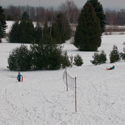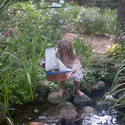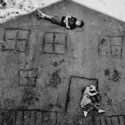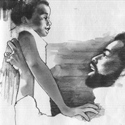It was raining on the interstate a week ago, and even the five-foot snowpiles lining the median were melting into greasy, gunpowder-colored sludge. Every few miles the snowmelt revealed a secret: a dead deer emerging from the melt like a tundra-bound mastodon, released to rot in the 60 degree weather. I never give much thought to dead deer on the side of the road; maybe a brief lament for the animal's awkward death or perhaps a thought to the human lives inconvenienced by it. But these deer were different, sitting as they were in the worsening gloop of winter, their once-brown hides now mottled gray yet still perfectly preserved as if they all had been killed that very day.
More than once I've walked into an abandoned building only to find the rotting carcass of a dead dog not far from the door. The feral animals, seeking some dignity at the end of lives that afforded little of it, seem to prefer to die indoors. I have also found dead dogs in vacant lots, and even the most dessicated of these corpses reveals some hint of a breed (such as a tuft of Rottweiler hair). The breeds of dogs whose bodies you find in fields or alleys usually tell you they were dumped there after losing an organized fight. Life in this town isn't easy for its people. You can imagine how hard it is on dogs.
Last night I was out walking our own former Detroit street dog (saved one day before his date with the needle), when we happened on a stray. Pinch-faced and skinny, the wild dog was only-slightly skittish. I ordered Wendell to sit by a tree while I approached: calming and petting it while looking for any sign of ownership. I brought it back to our porch where I fed it and then told it to get lost. I glanced out the window twenty minutes later and the stray was still sitting there, looking at me. The temperature dove into the low twenties last night. I begged my wife to close the blinds. "If it's still out there in the morning, I'll bring it to the shelter." But this morning it was gone.
On one of my first house scouting trips to Detroit, a friend gave me a tour of Belle Isle, the massive island park in the river between the city and Canada. He drove me past a barbed-wire fence enclosing overgrown foliage with a dozen albino deer huddled together. "European fallow deer," he said. "They've lived here for generations. They used to run wild on the island but now they're penned off in the abandoned zoo."
"Abandoned zoo?" I was intrigued.
Detroit does still have an operating zoo. A good one, in fact, built on an island of city-owned land two miles north of the city border, within wealthy Oakland County. But for over a century the city operated a separate facility first known as the Belle Isle Zoo (which opened in 1895---the same year the European deer were introduced to the island) and then the Children's Zoo (starting in 1947). In 2002, disgraced former mayor Kwame Kilpatrick closed the Belle Isle Children's Zoo despite opposition from the City Council, claiming the pressure of the city's $75 million budget deficit. City council overrode his veto and freed up $700,000 to reopen the zoo. In that year's November election 88 percent of Detroit voters approved a nonbinding ballot initiative to reopen it. Kilpatrick ignored both and shuttered the zoo, shipping off the animals and calling the move temporary. "We need to really figure out what we want there," Kilpatrick said. Of course the "temporary" closure became permanent. Kilpatrick used money appropriated for the reopening of the zoo to fund a "Nature Center" on the most remote and unvisited part of the 982-acre island, including $1 million for a brand new enclosure for the island's dwindling herd of 20 fallow deer.
Seven companies submitted bids to build it, and the city building authority (run by the mayor's cousin), selected a company that had never before built an animal enclosure against the bids of several experienced zoo contractors. The first act of the winning bidder was to subcontract the construction to a company owned by the former mayor's longtime best friend (and fellow convicted felon) Bobby Ferguson [source], a man who has benefited from an untold number of similar schemes over the years (to the tune of hundreds of millions in taxpayer dollars). That is how business is done in the city of Detroit. And these are some of the results:


 Miles and miles of perfectly adequate chain link animal enclosures abandoned so the former mayor's friend could pocket $1 million to build one on the opposite side of the island for 20 inbred European deer.
Miles and miles of perfectly adequate chain link animal enclosures abandoned so the former mayor's friend could pocket $1 million to build one on the opposite side of the island for 20 inbred European deer.
The Belle Isle Zoo has been closed now for over six years. Many people from this area have fond memories of visiting it as children. There were elephants here. Bears. Monkeys. Tigers. Some of the zoo's big cats were rumored to have been rescued from lives guarding Detroit crackhouses. In 1980, the zoo was completely rebuilt to adhere to more modern ideas of natural habitats with a lengthy elevated boardwalk and African-style architectural elements throughout. 22 years later it would all be left to rot:





 Kilpatrick lied about this zoo as effortlessly as he lied about nearly everything during his tenure. He once put forth some cockamamie idea about turning the zoo into an X-Games style park with skateboarding and "zip lines." But that will never happen. It will sit like this until the scrappers find their way in, followed by the graffiti artists and the drunks and vandals, though the place is a block from the island's main police station and not easy to enter (it's a maze of 10-foot barbed-wire fencing) .
Kilpatrick lied about this zoo as effortlessly as he lied about nearly everything during his tenure. He once put forth some cockamamie idea about turning the zoo into an X-Games style park with skateboarding and "zip lines." But that will never happen. It will sit like this until the scrappers find their way in, followed by the graffiti artists and the drunks and vandals, though the place is a block from the island's main police station and not easy to enter (it's a maze of 10-foot barbed-wire fencing) .
I did not go there with any intention to trespass. I often take the dog for hikes in the woods on Belle Isle. Inside of him a wild hunter sits dormant, and it is necessary to occasionally make him feel useful. Earlier this year a pack of wild dogs were harassing us, keeping their distance. They were smaller dogs than the ones that attacked us at the playground years ago, and once we started chasing them they led us right into the abandoned zoo. Inside the zoo, we followed their tracks through a maze of fences and walls. I could see that everything remained much as it had been left. The felid cages still had trees nailed to the walls for the scratching of giant claws. The monkey house sat silent, still smelling slightly of its occupation. The dog loved the smells of the old zoo, rooting around every corner of the cages or the big cat enclosure. He was the Teddy Roosevelt of German Shorthaired Pointers, the Hemingway of birddogs: a big game hunter, sniffing at ghosts.
The dog loved the smells of the old zoo, rooting around every corner of the cages or the big cat enclosure. He was the Teddy Roosevelt of German Shorthaired Pointers, the Hemingway of birddogs: a big game hunter, sniffing at ghosts. It was strange to stand inside the enclosures and look up to where countless people would have watched whatever animal dwelt there.
It was strange to stand inside the enclosures and look up to where countless people would have watched whatever animal dwelt there. Even stranger were the plants growing inside each enclosure, non-native species probably chosen carefully long ago to resemble the flora of wherever the animal was from but not to tempt them into nibbling. Even a simulacrum of wildness, abandoned, will become truly wild given enough time.
Even stranger were the plants growing inside each enclosure, non-native species probably chosen carefully long ago to resemble the flora of wherever the animal was from but not to tempt them into nibbling. Even a simulacrum of wildness, abandoned, will become truly wild given enough time.
 Every building and every enclosure chokes with overgrown plants in the summer. Dead trees have fallen to crush the boardwalk in places. The buildings are mostly intact, filled with snake and spider exhibits, educational displays. Scrapping damage seems light, though I do think the copper is gone. Signs inside the once-heated felid cages still warn KEEPER IN THE YARD.
Every building and every enclosure chokes with overgrown plants in the summer. Dead trees have fallen to crush the boardwalk in places. The buildings are mostly intact, filled with snake and spider exhibits, educational displays. Scrapping damage seems light, though I do think the copper is gone. Signs inside the once-heated felid cages still warn KEEPER IN THE YARD. A brush in a big cat cage sits next to an empty 40oz.
A brush in a big cat cage sits next to an empty 40oz. An animal transport trailer slowly rots into the ground.
An animal transport trailer slowly rots into the ground. From their earliest days, we teach our children about wild things. Even as more and more of them grow up in cities or suburbs, seemingly isolated from anything truly wild, we tell them stories and read them books about elephants and bears, monkeys and tigers. When you're a kid, almost all the good books are about these wild things, most anthropomorphized and friendly. To those of us reading these stories, this obsession with the wild might seem pointless or silly. But to a kid these pages are an introduction to our world and its amazing capacity for strangeness and beauty. We take our kids to the zoo---even ignore the unnerving vacant glaze in the eyes of penned polar bears---because we know there is nothing quite so magical to those tiny minds as seeing what was fiction become suddenly so real.
From their earliest days, we teach our children about wild things. Even as more and more of them grow up in cities or suburbs, seemingly isolated from anything truly wild, we tell them stories and read them books about elephants and bears, monkeys and tigers. When you're a kid, almost all the good books are about these wild things, most anthropomorphized and friendly. To those of us reading these stories, this obsession with the wild might seem pointless or silly. But to a kid these pages are an introduction to our world and its amazing capacity for strangeness and beauty. We take our kids to the zoo---even ignore the unnerving vacant glaze in the eyes of penned polar bears---because we know there is nothing quite so magical to those tiny minds as seeing what was fiction become suddenly so real. But in time, of course, every child will see a zoo for what it is: a place where nothing is real, a place where wild animals cannot be wild, where every instinct is curbed by confinement or scheduled feedings.
But in time, of course, every child will see a zoo for what it is: a place where nothing is real, a place where wild animals cannot be wild, where every instinct is curbed by confinement or scheduled feedings.
This place will never be a zoo again. It is home to a pack of wild dogs now. A reclusive badger or two. Red foxes and red squirrels. A bluejay and a cardinal. A mile away, the fallow deer sit in their million-dollar home, but within the zoo I still find a broad-tined antler shed by a buck during his temporary stay. Half buried in the ground, it is already starting to rot.
We take our kids to the zoo and think we're teaching them about wildness, but really we're teaching them about dominion. A lesson in the power of fences. While all the time, along our highways, outside our very windows, wild things are there. Waiting.
Copyright © 2005-2016 Sweet Juniper Media, Inc.
All Rights Reserved.
All Rights Reserved.
"Sweet Juniper" is a registered trademark.
No unauthorized reuse.
No unauthorized reuse.
Categories
- Friday Morning Street Urchin Blogging ( 107 )
- Detroit ( 60 )
- SAHD ( 34 )
- photography ( 30 )
- Thursday Morning Wood ( 25 )
- Halloween ( 23 )
- Thrift ( 18 )
- abandoned places ( 18 )
- terrifying nixon-era children's books ( 16 )
- Reminiscin' ( 15 )
- Sweet Juniper Media ( 11 )
- Wendell ( 10 )
- Design ( 9 )
- San Francisco ( 9 )
- nature fights back ( 9 )
- sleep ( 9 )
- if you ain't dutch you ain't much ( 8 )
- sentimental ( 7 )
- Music ( 6 )
- Parody ( 6 )
- birth story ( 6 )
- scrappers ( 6 )
- Sweet Juniper Tunes ( 5 )
- lawyering ( 5 )
- Zoo ( 4 )
- elegant leisure ( 4 )
- language ( 3 )
- feral houses ( 2 )
- theme parks of the damned ( 2 )
- zombies ( 1 )
Archives
- November 2017 ( 2 )
- December 2016 ( 1 )
- November 2016 ( 2 )
- December 2015 ( 1 )
- November 2015 ( 2 )
- December 2014 ( 1 )
- October 2014 ( 2 )
- April 2014 ( 1 )
- December 2013 ( 2 )
- November 2013 ( 1 )
- October 2013 ( 1 )
- September 2013 ( 2 )
- July 2013 ( 2 )
- June 2013 ( 1 )
- April 2013 ( 1 )
- March 2013 ( 3 )
- February 2013 ( 1 )
- January 2013 ( 1 )
- December 2012 ( 2 )
- November 2012 ( 1 )
- October 2012 ( 4 )
- September 2012 ( 2 )
- August 2012 ( 2 )
- July 2012 ( 1 )
- June 2012 ( 3 )
- May 2012 ( 1 )
- April 2012 ( 2 )
- March 2012 ( 1 )
- February 2012 ( 2 )
- January 2012 ( 1 )
- December 2011 ( 3 )
- November 2011 ( 3 )
- October 2011 ( 5 )
- September 2011 ( 3 )
- August 2011 ( 4 )
- July 2011 ( 4 )
- June 2011 ( 2 )
- May 2011 ( 4 )
- April 2011 ( 6 )
- March 2011 ( 7 )
- February 2011 ( 4 )
- January 2011 ( 4 )
- December 2010 ( 5 )
- November 2010 ( 7 )
- October 2010 ( 5 )
- September 2010 ( 4 )
- August 2010 ( 5 )
- July 2010 ( 7 )
- June 2010 ( 5 )
- May 2010 ( 5 )
- April 2010 ( 5 )
- March 2010 ( 4 )
- February 2010 ( 5 )
- January 2010 ( 5 )
- December 2009 ( 6 )
- November 2009 ( 5 )
- October 2009 ( 8 )
- September 2009 ( 9 )
- August 2009 ( 6 )
- July 2009 ( 9 )
- June 2009 ( 8 )
- May 2009 ( 8 )
- April 2009 ( 8 )
- March 2009 ( 12 )
- February 2009 ( 11 )
- January 2009 ( 9 )
- December 2008 ( 11 )
- November 2008 ( 9 )
- October 2008 ( 14 )
- September 2008 ( 11 )
- August 2008 ( 11 )
- July 2008 ( 12 )
- June 2008 ( 10 )
- May 2008 ( 9 )
- April 2008 ( 8 )
- March 2008 ( 10 )
- February 2008 ( 15 )
- January 2008 ( 12 )
- December 2007 ( 9 )
- November 2007 ( 12 )
- October 2007 ( 11 )
- September 2007 ( 13 )
- August 2007 ( 11 )
- July 2007 ( 8 )
- June 2007 ( 12 )
- May 2007 ( 10 )
- April 2007 ( 10 )
- March 2007 ( 12 )
- February 2007 ( 14 )
- January 2007 ( 12 )
- December 2006 ( 11 )
- November 2006 ( 10 )
- October 2006 ( 13 )
- September 2006 ( 8 )
- August 2006 ( 13 )
- July 2006 ( 13 )
- June 2006 ( 15 )
- May 2006 ( 13 )
- April 2006 ( 9 )
- March 2006 ( 10 )
- February 2006 ( 3 )
- January 2006 ( 5 )
- December 2005 ( 2 )
- November 2005 ( 8 )
- October 2005 ( 4 )
- September 2005 ( 1 )
- July 2005 ( 3 )


























